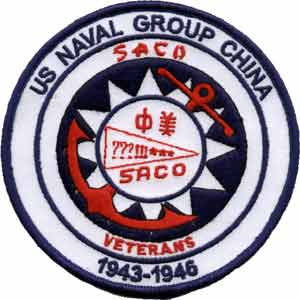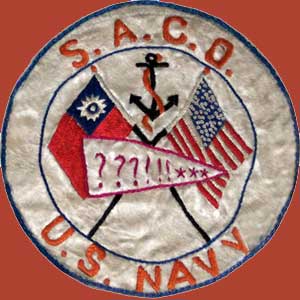 Dad never did talk much about his service with the US Navy in World War II. We knew he was in China working with some secretive organization, and several cool and exotic souvenirs were displayed in the house. We heard occasional stories, but it was many years before we discovered the album containing photos taken by Dad. The more we learn of the operations of the little known Sino-American Cooperative Organization, the more we want to preserve some of the history, and share memories with surviving members and families.
Dad never did talk much about his service with the US Navy in World War II. We knew he was in China working with some secretive organization, and several cool and exotic souvenirs were displayed in the house. We heard occasional stories, but it was many years before we discovered the album containing photos taken by Dad. The more we learn of the operations of the little known Sino-American Cooperative Organization, the more we want to preserve some of the history, and share memories with surviving members and families.
After my brother"s and my service in Vietnam in the early 70s, we collected and organized some memories. We had photos, some letters written home, memories of stories, and the sometimes failing memories from Dad. His old letters were not usually revealing, and he related that his CO warned them of professionalism about protecting information when writing home, but that the appointed censors were to pass on the letters without reading anyone"s private correspondence. So we began with the few letters that had survived.
Enlisting in the Navy late 1942, Dad trained at Camp Peary, Williamsburg, VA, in the newly formed Naval Construction Training Center. As a new Seabee in NMCB 74, he was learning infrastructure building skills essential to the Pacific campaign in support of Marine amphibious operations. Training and liberty must have been good, as he met his future wife (my mother) in Virginia. Before shipping out, he was hit by a drunk driving a Navy truck, and hospitalized. During recovery, his rating was changed to StoreKeeper, and being a former accountant he picked up on this quickly. His skills and temperament seemed to match what the Navy was looking for in a secret mission being recruited, and he volunteered. (Read more of the history and accomplishments of the SACO Tigers).
After acceptance for the new assignment, he trained for multi-duty operations, learned rudimentary Mandarin Chinese, and left for an overseas tour in February, 1945.
First letter we have is dated 21 October 1945 from Nantei, China. Mail came from Kienow, and Dad received "64 letters last week and 13 more today." This was the first batch received by the outfit since end of the war. They are setting up a mail delivery from Shanghai to Kienow semi-monthly, and the group will send a courier from there.
The family had asked what he was doing in China, but "guess we will never be able to talk much about it as it is quite secretive. Some has been released about the organization but it will never be told the true story. It would be too dangerous for too many people who are left in this country as well as not wise to give away your secrets and methods."
"Concerned about getting money to family . . . " (Dad was primary support for mother and aunt, as well as wife) ". . . no method to send out money from China. " Had almost the equivalent of $600 US, but was paid in Chinese Yuan. Exchange rate fluctuates, and he cannot reveal the rate since that was one of the restrictions. (later we found the official rate of exchange was close to 20 Yuan to 1 US dollar, but the black market rate was sometimes as much as 2000 to one - terrible disadvantage to be paid in Chinese dollars.) Dad mentioned he had some Chinese silver dollars, and some paper currency, which we treasure as reminders today.
Letters always talked about the family farm in Missouri, what to do with the corn in the fields, whether to sell or keep one of the cows, what to prepare to buy, etc.
"I wish that I could say that I would be home soon but I am afraid that I can"t. Under the point system I already have enough points to get a discharge under the present setup, but I couldn"t get a discharge if I had a hundred points. Don"t know when they will relieve us and get us out of here. We are hoping that they will let the Chinese do it from here on out . . . " At the time, the point system allowed for anyone accruing 41 points to be eligible for shipping home, and Dad had about 45. "Maybe I can make it by the first of March but I am afraid to make any guesses as it is quite possible that they keep me here a long time." (We later learned that Captain Miles asked him to stay longer and even to extend service since they were in such need of supply skills, as they dispersed equipment and provisions to the Chinese army. His service was commended with the complement that his reports had been the most reliable of any coming out of China.) Dad felt he needed to be back to the farm in the spring to plant, to take care of his own mother. My mother had sent a request to her Senator Byrd requesting hardship release for him to return.
In October, he took the examination for Chief Storekeeper Disbursing - CSK(D) , and scored so well that Commander Schoettler recommended him for promotion. He was hopeful it could be effective first of next month, but it turned out that the process to convene a board for Chief in the theater was difficult and lengthy, and only one had been accomplished.
While in Fukien, Dad picked up many novelty items to bring home to the family and found some collectible treasures we keep in the family. Some that are really special include three sets (one each for wife and two sisters) of 12 place setting silver flatware, hand-hammered from Mexican silver dollars. The Chinese silversmith explained that Mexican silver dollars contained a higher silver content than either Chinese or American. One of the letters talked of picking up a pipe for his uncle who smoked tobacco. There was a concern that the pipe was heavy to bring, made of brass, and large at the bottom to hold water, and that the pipes were used to smoke opium as well as tobacco. Then he explained the operation with the water cleansing the smoke, and the Chinese who continued to smoke opium even though it was strictly forbidden. Do not know if he ever did acquire a water pipe, but he did accumulate two hand-carved chests full of handicrafts distributed to the family. The chests were crated and carried on board, but one was "lost" in transit. He related a story of the CPO on the docks who diligently searched and found the missing chest that had been relabeled in an attempt to steal it. They had traced the owner from the name of my mother that had been carved on the chest. Unfortunately, many of the contents inside had been pilfered.
Other mementos of Navy service are still in the family, and are treasured by the grandchildren. As a kid my brother and I used to play with an Indian Ghurka knife (khukuri), which Dad remembered getting in Burma, and a Japanese kitana
"Type 94" Non Commissioned Officer"s sword, which he cannot recall where it was obtained. We still have some of his uniforms, that were sent home before deploying, and of course the discharge uniform.
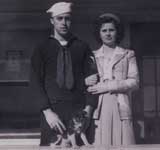
Mentions one of their ships came in from Namoy (Quemoy, now known as Kimen) with some white sugar and two pounds of butter. "Did not expect it to last long with 23 of them to share. "
Letter on October 25th, Dad had learned that they could talk some about where they had come from, and relate stories that did not reveal operational secrets. (Using text in these later letters as guidance, I pieced together some of the activities of his particular group.)
He had left the states via San Pedro, California on Feb 6, 1945 and sailed for a destination unknown to them. The cruise was uneventful except for some storms and rough water around the South Seas. Disembarked in Melbourne for 3 days, then set off towards Indonesia in a "president class frigate." They were escorted by a British sloop, that turned back at the halfway point. For about two days, they sighted enemy ships, and then were spotted by a Japanese destroyer. At their top speed of 22 knots they could not outrun the destroyer, and prepared for battle. Their transport had been fitted with 5 inch guns replacing the standard 3 inch, and when they opened fire, they scored a hit on the first volley. The enemy destroyer broke off and they continued on. Two days later Japanese planes found them, but they were repelled with the ships anti-aircraft guns. Dad marveled at the effect of the five-barrel guns that were able to down one plane quickly. After this ordeal things were quiet until the last day out of Bombay, India. They detected three submarines under water, and were spotted and fired upon with two torpedoes about midnight. The transport dodged "the two fish" and both missed, and they made a run for the bay. Subs could only follow about 8 knots so they were soon out of range. The transport arrived in Bombay, after a suspenseful and stressful journey.
Stayed in Bombay about two days, then were issued a .45 Colt, M1 30 caliber carbine, and boarded the Great Indian Peninsular Railway heading west. The train passed through Agra and the men were awed by the Taj Mahal. My Dad had previously done some photography, and was extremely disappointed that he had no camera at the time. He did some bargaining and was authorized to carry a folding Kodak Retina camera from that point forward. He took candid photos for the duration of his tour, and experiences in the CBI campaign are documented with the collection of his photos he was allowed to keep, which are now in the family.
The train trip was rough with shortage of rations and drinking water, but made the journey to West Bengal outside of Calcutta in makeshift Camp Chepara, which was described as tents in the jungle. Later they moved into Calcutta Fort Knox, and worked there for a few months, traveling on occasion to Assam and Burma, in support of OSS Detachment 101, which was subsequently disbanded early July.
In July, LCdr Robert J. Schoettler was sent from Kunming to recruit a group for the SACO Intelligence unit, which came to be known as PACT Shot. The group was to proceed to Japanese occupied territory on the east coast of China, and prepare hydrographic surveys of the coast in preparation for an Allied landing in Fukien province. Late in July the new group went to Jorhat for three days, then flew C-46s over the hump to Kunming, China, HQ for the 14th AAF and the home of the Flying Tigers.
 The new members made up an operational group of less than 50. The new contingent traveled by foot and truck over Ledo Road (last leg of Burma Road into China) and setup temporarily in mountains at Camp Hank Gibbins, for some in-country training. The camp shared facilities with the Fleet Radio Unit China (FRUCHI) that had been operating since late 1942 analyzing intercepted Japanese radio traffic. (Several
photos are included at Camp Gibbins, with many members of the group identified.) This was a primary training facility located about 15 miles northwest of Kunming. Daily duties included intelligence gathering and arranging for distribution of Lend-Lease supplies to Chinese guerrillas being trained by SACO. Normal travels in the country were in small groups of two or three sailors, often accompanied by Chinese SACO serving as interpreters. American SACO members were well received by Chinese citizens and often guarded by Tai Li"s agents. The Japanese had been aware of SACO activities since 1942 and operatives had a price on their head, but only three were captured during the course of the war.
The new members made up an operational group of less than 50. The new contingent traveled by foot and truck over Ledo Road (last leg of Burma Road into China) and setup temporarily in mountains at Camp Hank Gibbins, for some in-country training. The camp shared facilities with the Fleet Radio Unit China (FRUCHI) that had been operating since late 1942 analyzing intercepted Japanese radio traffic. (Several
photos are included at Camp Gibbins, with many members of the group identified.) This was a primary training facility located about 15 miles northwest of Kunming. Daily duties included intelligence gathering and arranging for distribution of Lend-Lease supplies to Chinese guerrillas being trained by SACO. Normal travels in the country were in small groups of two or three sailors, often accompanied by Chinese SACO serving as interpreters. American SACO members were well received by Chinese citizens and often guarded by Tai Li"s agents. The Japanese had been aware of SACO activities since 1942 and operatives had a price on their head, but only three were captured during the course of the war.
Leaving Camp Gibbins in late August, PACT Shot flew to Zhijiang airfield but stayed only a few hours. They then continued toward Nantei near Foochow with nine planes but encountered storms. Six planes turned back, one was lost with crew bailing out (crew successfully bailed), one made it through to Kienow, and Dad"s ran short of fuel and were considering bailing out. Only 12 parachutes were available for 13 fliers, but two immediately offered to share a single chute. Luckily, parachuting was not required as an unknown airstrip was found just in time to make "a forced landing and the pilot won our admiration as he made a beauty under the conditions."
It was fortunate to touch down before completely running out of fuel, but a Japanese airstrip is not the ideal location! The date was August 31, 1945, and the Americans were awaiting Japan's surrender in China. (After the A-bombs, but before Japan had surrendered in China. Unconditional surrender came September 2, but the capitulation did not happen in Nanking until September 9. Some Japanese in China did not accept the terms, and some had not even been officially notified until weeks later.) Upon the forced landing, the C-47"s radios initially could not contact anyone, but the Chinese guerrillas were finally in the early evening and help was estimated to be a day away. The group recognized Japanese troops on the airfield, and left the plane to hide in bordering tall grass. Japanese reinforcement trucks with machine guns arrived, and demanded that the Americans give up. Without resisting, the Senior Officer in Charge (LTJG Frank McKenzie) surrendered the group, and all returned toward the plane except my dad Smitty, the radioman, and one sailor. Dad wrote "They were afraid to not give up and I was afraid to give up." The Japanese were not certain how many were hiding, nor what weapons were carried. The plane had been packed with gear for many and was piled with seabags so it was difficult to count the number aboard. The ten surrendered prisoners were taken to a dilapidated compound at the end of the airstrip, and the area was surrounded. As darkness fell, searchlights were brought out and search parties fanned out not far from the runway. Dad narrates he tracked the sentries and gun placements easily from his vantage in tall grass and trenches just a short distance from the plane. After about an hour, the situation became too tense and he sneaked through the sentry lines away from the strip, but still in sight of the C-47. The two others followed, and they all could rest easier for a while. A dog was brought in to help with the search, and it came very close to Smitty, but would not reveal his position. Dad was always good with dogs, and he gently talked with and soothed this one, and his position was never compromised. This dog proved not to be a highly trained war canine!
During this time the captives communicated as best they could that the war was about over, and that the Chinese guerrillas were on the way to help anyway. It was hoped that the Japanese would feel impending defeat, and provide fuel to fly out the next morning. The senior officer yelled out to the group to give up and everything would turn out well. Smitty came back in closer, again through the perimeter lines, to get close enough to talk. While hiding and moving as he spoke, he insisted that he was not ready to come in. The airman finally decided giving up was the most expedient course and that he needed to join his plane crew as the refueling from cans started and plane engines were to be tested. He was fearful of missing the flight if it took off, but Dad was more afraid of taking off in a plane with almost no fuel. However, the plane was just being taxied to a spot nearer the compound. The sailor also started to follow, but before reaching the group, the unidentified sailor returned to the safety of the grass.
The negotiating officer ordered everyone in, apparently threatening that the Japanese would execute the Americans if all could not be secured. Dad again was not sure what they would do and was adamant about giving up his M1 carbine and 45 pistol.
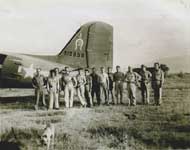
With the standoff, the officers then tried to negotiate to let Smitty come in, but with the stipulation that he could keep his weapons, and that the plane would be refueled in the morning. Finally Dad agreed so long as he could keep his weapon trained on one of the Japanese officers. A Japanese officer walked out who spoke no English and about as much Mandarin as Dad, but they worked out an understanding, and he walked in, along with the other sailor who surrendered his guns immediately. Treatment was good, and Dad spent the rest of the night with a sentry at the plane, while he held his pistol strategically pointed the rest of the night. He narrates, "I wasn"t planning on shooting until they did as I knew I would lose. At daylight I got up and brushed the weed seed out of my now gray hair (lost 10 years) and got the others up . . .refueled with the Japanese gas and took off." Dad even got a picture of a sentry at the airfield, and a group shot of some very relieved men before leaving. He was threatened with a courts martial for disobeying orders, but nothing ever came of it. He swore at the time he would never get on another plane as long as he lived, unless it was headed for the states. He did have occasion to fly several times again, but continued to have some problems on the porly maintained airfields as seen in some of the photos. (To this day he has a fear of flying, and needs a lot of encouragement to step on a plane.)
Sal Ciaccio was a participant in this ordeal, and he remembers the Japanese treating them well, serving them a meal with sake. After the incident, Dad was unofficially reprimanded for disobeying orders, but there was uncertainty about the legality of ordering surrender to the enemy. Captain Miles reviewed the incident and dismissed any further action. The C-47 was with the 3
SKD1c W.E. Smith
BM2c R.J. Allaire
BM2c Lloyd T. Cobb
BM1c L.E. Roach
MM1c Rudy P. Jakmas
MoMM1c Sal J. Ciaccio
CCM P.V. Redman
ENS Billy W. Houck
LTJG Frank E. McKenzie
PACT Shot united in Kienow, and embarked on a trip south on the Min River towards Foochow.
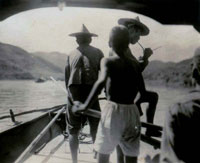 Travel was primarily on local sampans, with the Americans hiding below deck while Chinese piloted the craft. Even with the official Japanese unconditional surrender, work remained to prepare for disarment of Japanese forces. Many of the SACO groups were ordered to make their way to collection points, and were then provided transportation to Shanghai awaiting rotation home. PACT Shot was to continue with the survey of areas around Foochow to Amoy. Many of this SACO group did not leave China until the end of the year, and a group photo taken November 11, 1945.
Travel was primarily on local sampans, with the Americans hiding below deck while Chinese piloted the craft. Even with the official Japanese unconditional surrender, work remained to prepare for disarment of Japanese forces. Many of the SACO groups were ordered to make their way to collection points, and were then provided transportation to Shanghai awaiting rotation home. PACT Shot was to continue with the survey of areas around Foochow to Amoy. Many of this SACO group did not leave China until the end of the year, and a group photo taken November 11, 1945.
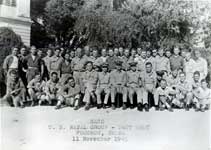 As dad talks more and we connect some of the pieces, more will be shared. And, the best stories are told by the photos, so check out the
Web Gallery of several hundred photos from 1945 India and China.
As dad talks more and we connect some of the pieces, more will be shared. And, the best stories are told by the photos, so check out the
Web Gallery of several hundred photos from 1945 India and China.
(Read more of the history and accomplishments of the SACO Tigers and the China Burma India theater).
![]() Send e-mail to
Randy@computersmiths.com
Send e-mail to
Randy@computersmiths.com
Page last updated
